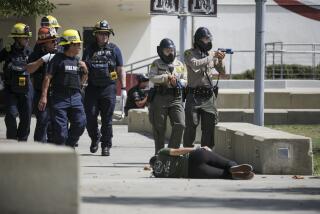Hard Facts on Helmet Law : Experts Say More Young Bike Riders Are Wearing Headgear and Fewer Are Being Hurt
Lia Rousset, 17, was bicycling to school last month when she hit “some kind of little pole” and was knocked unconscious.
“That day, I was thinking, ‘I don’t want to wear my helmet,’ ” recalled the Newport Harbor High School junior. “I had a ski hat on, and the helmet was getting in the way, but I decided to wear it anyway.”
She is glad she did. As she convincingly found out, a helmet “could make or break your life.”
Averting serious head injury as Lia did is just what doctors, law enforcement officials and state legislators say California’s bicycle helmet law was designed to do. At the end of the law’s first year, physicians say more youths are wearing helmets and fewer are suffering head injuries.
The law, which took effect in January, 1994, prohibits a person younger than 18 from operating a bicycle or riding one as a passenger without a helmet.
Beginning this year, violators face a maximum $25 fine, for which parents or guardians are liable.
“We’ve seen a substantial increase in the number of children admitted for bicycle-related injuries who were wearing a helmet,” said Dr. Gary Goodman, co-director of pediatric intensive care at Children’s Hospital at Mission Hospital Regional Medical Center in Mission Viejo. “We would like to think it’s due to the law.”
Records at Children’s Hospital show that in 1993, one of 19 children admitted for bicycle-related injuries wore helmets. From January to September, 1994, five of the 14 children admitted for bicycling injuries were wearing helmets and seven were not. Circumstances in the other two cases were unclear.
The California Highway Patrol reports that more children wore helmets last year than in 1993, and that the number of bicycling deaths and injuries has declined.
In California in 1993, of the 133 bicyclists killed, only 12 were wearing helmets. Thirty-three of the victims were children.
From January to July of last year, 69 cyclists died, 33 of them children. Of those who died, 10 were wearing helmets.
Officials hesitate to make a connection between the increased use of helmets and the decrease in deaths and injuries.
“We need to have a couple more years to see if there’s any correlation,” said Steve Kohler, CHP spokesman in Sacramento.
The CHP believes that imposing a fine will make the helmet law more effective. In addition, it is sponsoring a “Heads Up, Helmets On” campaign to include a poster contest. The winner’s drawing will be used on billboards and he or she will be awarded a bike, a helmet and a trip to Sacramento.
Doctors say children wearing helmets come to emergency rooms with less serious injuries.
“They’re still coming in with extremity injuries, but they’re not as bad as they would be without a helmet,” said Dr. Patrick Romano, a pediatrician at UC Davis Medical Center.
According to the Children’s Advocacy Institute, a helmet can reduce the risk of severe head injury by 85%.
Doctors say much of the increase in helmet use can be attributed to a push by schools to teach students the importance of bicycle safety.
Another factor may have been a drop in the cost of helmets in 1994, said Steve Barrow, legislative director for the institute.
Helmets normally cost $30 to $100, but some are available for less. Safe Moves, based in Marina del Rey and the largest educational bicycle safety program in the country, sells helmets for as low as $10, said director Pat Hines. It also sells a helmet with a blinking red light on the back that can be seen up to 1,000 feet away, she said.
*
The state’s safety campaign is taking a different approach in 1995, with additional penalties for failing to wear a helmet.
At their discretion, police officers can call for fines against offenders.
The first violation results in an oral warning. A second offense draws a written warning and the offender may be required to attend bicycle safety classes with his or her parents.
A third offense results in a citation and possibly an appearance in Juvenile Court and a maximum fine of $25.
Officers can choose to give verbal warnings instead of imposing the stiffer punishments.
More to Read
Sign up for Essential California
The most important California stories and recommendations in your inbox every morning.
You may occasionally receive promotional content from the Los Angeles Times.










